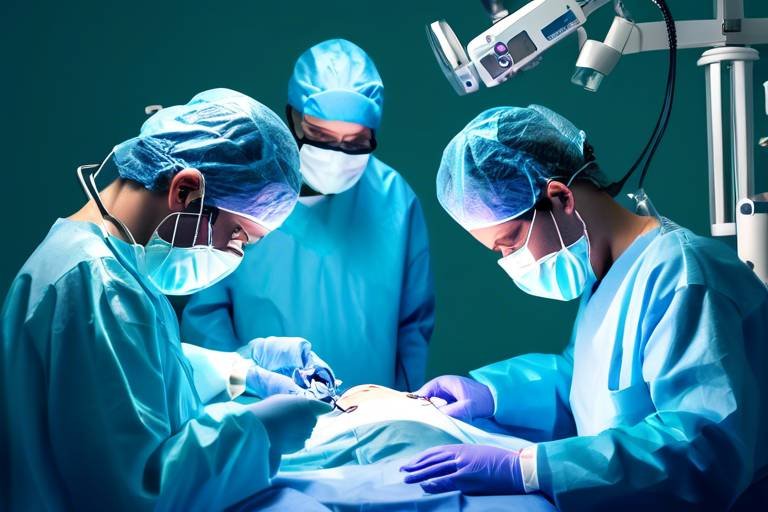AI in Surgery: How Far Can We Go?
The landscape of healthcare is undergoing a seismic shift, and at the heart of this transformation is artificial intelligence (AI). As we dive deeper into the realm of surgery, the question arises: how far can we go with AI? This article embarks on a journey to explore the remarkable advancements that AI has brought to surgical practices, the challenges that accompany these innovations, and the exciting future that awaits both healthcare professionals and patients alike.
Imagine a world where surgical precision is not just a goal but a guarantee. With AI stepping into the operating room, that vision is becoming a reality. From robotic-assisted surgeries that enhance a surgeon's capabilities to predictive analytics that forecast surgical outcomes, AI is redefining what is possible in the surgical field. However, this integration is not without its hurdles. Ethical dilemmas, data privacy concerns, and the necessity for rigorous training pose significant challenges that we must navigate as we embrace this technology.
As we explore the current applications of AI in surgery, it's essential to acknowledge how these technologies are being woven into the very fabric of surgical procedures. AI is not merely an accessory; it is becoming an integral part of the surgical toolkit. Surgeons are now equipped with advanced algorithms that assist in everything from preoperative planning to postoperative care, ensuring that each step of the surgical process is optimized for success.
In the following sections, we will delve into the myriad benefits that AI brings to surgical procedures, such as improved patient outcomes and reduced recovery times. We will also discuss the challenges that must be addressed to fully harness the potential of AI. Finally, we will look ahead to the future trends in AI-assisted surgery, where personalized approaches and collaboration between AI and human expertise will pave the way for groundbreaking advancements.
So, buckle up as we navigate the thrilling intersection of technology and medicine. The journey into the world of AI in surgery is not just about machines and algorithms; it's about enhancing the human experience in healthcare. Together, we will uncover how far we can truly go with AI, and what that means for the future of surgical practices.
- What are the main applications of AI in surgery? AI is used in robotic surgeries, predictive analytics for outcomes, and improving surgical precision.
- How does AI improve patient outcomes? By enhancing accuracy in procedures, reducing recovery times, and aiding in better decision-making.
- What challenges does AI face in surgical settings? Ethical concerns, data privacy issues, and the need for extensive training for healthcare professionals.
- What does the future hold for AI in surgery? We anticipate advancements in personalized surgical approaches and greater collaboration between AI systems and surgeons.

Current Applications of AI in Surgery
Artificial Intelligence (AI) is making waves in the surgical field, transforming the way procedures are performed and enhancing patient care. Imagine a world where surgeries are not only safer but also more precise—this is the promise of AI in surgery. From robotic surgery to predictive analytics, AI technologies are being integrated into various surgical practices, leading to remarkable advancements.
One of the most significant applications of AI in surgery is through robotic-assisted surgery. These systems are equipped with advanced algorithms that allow for greater precision in surgical movements. For instance, robots like the da Vinci Surgical System enable surgeons to perform complex procedures with minimal invasiveness. This means smaller incisions, less pain, and quicker recovery times for patients. Surgeons can operate with enhanced visualization and dexterity, making it easier to navigate delicate structures within the body.
Moreover, AI is revolutionizing surgical planning through predictive analytics. By analyzing vast amounts of data from previous surgeries, AI can forecast potential complications and outcomes. This capability allows surgeons to make informed decisions before even stepping into the operating room. For example, AI systems can evaluate a patient’s medical history, imaging studies, and other relevant data to provide insights on the best surgical approach. This not only improves the chances of a successful surgery but also enhances patient safety.
Additionally, AI technologies are being used for image recognition during surgery. With the help of machine learning algorithms, AI can assist in identifying anatomical structures in real-time, providing surgeons with critical information as they operate. This level of support can significantly reduce the risk of errors and improve overall surgical outcomes.
In summary, the current applications of AI in surgery are paving the way for a new era of medical practices. By enhancing precision, improving surgical planning, and providing real-time support during procedures, AI is transforming the surgical landscape. As we continue to explore these advancements, the potential for improved patient care and outcomes becomes increasingly evident.

Benefits of AI Integration in Surgical Procedures
The integration of artificial intelligence (AI) into surgical procedures is not just a trend; it is a transformative leap that has the potential to redefine the landscape of healthcare. Imagine a world where surgeries are not only performed with remarkable precision but also tailored to the unique needs of each patient. This is the promise that AI brings to the operating room. By leveraging advanced algorithms and data analytics, AI enhances surgical practices in numerous ways, leading to improved patient outcomes and a more efficient healthcare system.
One of the most significant advantages of AI in surgery is its ability to enhance decision-making capabilities for surgeons. With AI systems analyzing vast amounts of data, including patient histories, imaging results, and even real-time surgical metrics, surgeons can make more informed decisions. This level of insight allows for better planning and execution of surgical procedures, ultimately resulting in fewer complications and quicker recovery times.
Moreover, AI contributes to improved patient outcomes. Studies have shown that surgeries assisted by AI technologies often lead to decreased rates of postoperative complications. For instance, AI can predict potential risks based on a patient’s medical history, allowing surgeons to take preventive measures before the surgery even begins. This proactive approach not only saves lives but also significantly reduces the time patients spend in recovery.
In addition, the incorporation of AI in surgical procedures fosters enhanced precision and accuracy. Surgical robots, powered by AI, can perform delicate tasks with a level of precision that surpasses human capability. These robots can execute movements that are consistent and repeatable, minimizing the risk of human error. For example, during a complex procedure such as a laparoscopic surgery, AI-driven robotic systems can assist surgeons in navigating intricate anatomical structures with unparalleled accuracy, leading to better surgical outcomes.
Furthermore, AI is revolutionizing the realm of predictive analytics for surgical outcomes. By analyzing historical data and current patient information, AI can forecast potential complications and outcomes. This predictive capability allows surgeons to prepare for various scenarios, thereby enhancing their ability to manage unexpected challenges during surgery. The table below illustrates some of the key benefits of AI integration in surgical procedures:
| Benefit | Description |
|---|---|
| Improved Patient Outcomes | AI helps predict complications, leading to proactive measures and better recovery rates. |
| Enhanced Decision-Making | AI analyzes data to assist surgeons in making informed choices before and during surgery. |
| Increased Precision | Robotic systems powered by AI allow for highly accurate surgical interventions. |
| Predictive Analytics | AI forecasts surgical outcomes, helping to prepare for potential complications. |
In summary, the benefits of AI integration in surgical procedures are profound and far-reaching. From enhanced precision and improved patient outcomes to better decision-making capabilities and predictive analytics, AI is paving the way for a new era in surgery. As we continue to explore the potential of AI in healthcare, it becomes increasingly clear that this technology is not just a tool; it is a partner in the quest for better surgical practices and patient care.
- What is AI in surgery? AI in surgery refers to the use of artificial intelligence technologies to assist and enhance surgical procedures, improving accuracy, decision-making, and patient outcomes.
- How does AI improve surgical precision? AI improves surgical precision through advanced robotic systems that can perform intricate tasks with greater accuracy than human hands.
- Are there any risks associated with AI in surgery? While AI offers many benefits, there are concerns regarding data privacy, ethical implications, and the need for rigorous training for healthcare professionals.
- What does the future hold for AI in surgery? The future of AI in surgery looks promising, with ongoing research leading to personalized surgical approaches and better collaboration between AI and surgeons.

Enhanced Precision and Accuracy
In the realm of surgery, precision and accuracy are not just buzzwords; they are the cornerstones of successful outcomes. Imagine a world where every incision is calculated with the utmost care, where the margin for error is reduced to nearly zero. This is the promise that artificial intelligence (AI) brings to the surgical table. By leveraging advanced algorithms and machine learning techniques, AI systems are transforming how surgeons approach their craft, enhancing both the quality of care and the overall patient experience.
One of the most significant advancements in this area is the development of AI-assisted imaging technologies. These tools analyze medical images with incredible detail, allowing surgeons to visualize the anatomy of a patient in ways that were previously unimaginable. For instance, AI can highlight critical structures such as blood vessels and nerves, helping surgeons avoid potential complications during procedures. This level of insight leads to more informed decision-making and ultimately results in better surgical outcomes.
Moreover, AI systems can assist in the planning phase of surgery. By utilizing vast amounts of data from previous surgeries, AI can predict the best surgical approach for each unique case. This predictive capability is not only beneficial for choosing the right technique but also for anticipating potential complications. One could think of AI as a seasoned navigator, guiding surgeons through the complex landscape of human anatomy with unparalleled accuracy.
Another fascinating aspect of AI’s role in enhancing precision is its application in robotic-assisted surgeries. These systems, equipped with AI, allow surgeons to perform intricate procedures with enhanced dexterity and control. For example, during laparoscopic surgeries, AI-driven robots can stabilize instruments, filter out unnecessary movements, and even provide real-time feedback on the surgical technique being employed. This level of control translates to fewer errors, reduced blood loss, and shorter recovery times for patients.
To illustrate the impact of AI on surgical precision, consider the following table that compares traditional surgical methods with AI-assisted techniques:
| Aspect | Traditional Surgery | AI-Assisted Surgery |
|---|---|---|
| Precision | Moderate | High |
| Recovery Time | Longer | Shorter |
| Complication Rates | Higher | Lower |
| Surgeon Fatigue | High | Reduced |
As we delve deeper into the potential of AI in surgery, it's essential to recognize that while the technology enhances precision, it does not replace the need for human expertise. The best surgical outcomes arise from the harmonious collaboration between AI systems and skilled surgeons. Think of it as a well-rehearsed duet, where each performer plays a vital role in creating a masterpiece.
In conclusion, the integration of AI into surgical practices marks a significant leap toward achieving enhanced precision and accuracy. With ongoing advancements, we can expect even more sophisticated tools that will not only improve surgical outcomes but also redefine the standards of patient care. The future of surgery is bright, and AI is leading the way.

Robotics in Minimally Invasive Surgery
Imagine a world where surgery is not just about the skill of the surgeon but also about the precision of machines that work alongside them. has emerged as a game-changer, transforming the way surgical procedures are performed. With the integration of advanced robotic systems, surgeons can operate with enhanced precision, reduced trauma, and quicker recovery times for patients. This innovative approach allows for smaller incisions, which means less pain and faster healing.
One of the most significant advantages of robotic-assisted surgery is the increased dexterity it offers. Unlike traditional surgical methods, where the surgeon's hands may be limited by the size of the incision, robotic systems provide a level of control that is simply unparalleled. The robotic arms can maneuver with a range of motion that exceeds that of the human wrist, allowing surgeons to perform intricate procedures with remarkable accuracy. For instance, in a robotic prostatectomy, the surgeon can precisely navigate around delicate nerves, minimizing damage and preserving function.
But how does this technology actually work? Robotic surgical systems typically consist of three main components: the surgeon’s console, the robotic arms, and the camera system. The surgeon operates from a console, controlling the robotic arms with hand movements while viewing a high-definition, 3D image of the surgical site. This setup not only enhances the surgeon's visualization but also translates their movements into precise actions performed by the robotic instruments. It's almost like having a superpower in the operating room!
However, it’s important to note that while robotics in surgery offers many benefits, it is not without challenges. Training and expertise are crucial for surgeons to effectively utilize these systems. The learning curve can be steep, and not all surgical teams have immediate access to the necessary training or resources. Furthermore, the cost of robotic systems can be a barrier for some healthcare facilities, potentially limiting patient access to these advanced surgical options.
Despite these challenges, the future of robotics in minimally invasive surgery is incredibly promising. As technology continues to evolve, we can expect even more sophisticated robotic systems that are capable of performing a wider range of procedures. Imagine a future where surgeries are not only safer and more effective but also tailored to the unique anatomy of each patient. This level of customization could revolutionize the field of surgery, making it more patient-centered than ever before.
In conclusion, robotics in minimally invasive surgery represents a significant leap forward in surgical practices. By combining human expertise with cutting-edge technology, we can enhance surgical outcomes and improve patient experiences. As we continue to explore the potential of robotics in healthcare, one thing is clear: the future of surgery is bright, and it’s only just beginning.

Predictive Analytics for Surgical Outcomes
Predictive analytics is revolutionizing the way surgeons approach their craft, providing them with invaluable insights that can significantly enhance surgical outcomes. By leveraging vast datasets, AI algorithms can identify patterns and trends that may not be immediately apparent to human practitioners. This ability to analyze historical data allows for a more informed approach to surgical planning, ultimately leading to better patient care.
Imagine walking into a surgical room equipped with not just a scalpel and sutures, but also a sophisticated AI system that has analyzed thousands of similar cases. This system can predict potential complications and suggest personalized strategies to mitigate risks. For instance, it can assess a patient's unique health profile, including factors like age, medical history, and even genetic markers, to forecast how they might respond to a specific procedure.
One of the key advantages of predictive analytics is its capability to enhance decision-making during the preoperative phase. Surgeons can utilize AI tools to run simulations that predict various outcomes based on different surgical techniques. This means they can weigh the pros and cons of each approach before making a final decision. The result? A tailored surgical plan that aligns closely with the patient's needs, leading to improved recovery times and reduced complications.
Furthermore, predictive analytics doesn’t stop at the operating table. Postoperative care is equally critical, and AI can continue to play a role in monitoring recovery. For example, machine learning algorithms can analyze real-time data from wearable devices or hospital monitors to flag any concerning trends in a patient’s recovery process. This proactive approach allows healthcare providers to intervene early, potentially preventing serious complications.
However, the integration of predictive analytics in surgical outcomes does raise some important questions. How do we ensure the accuracy of the data being analyzed? What measures are in place to protect patient privacy? These are crucial considerations that healthcare professionals must address as they embrace this technology. Moreover, the need for ongoing training and education for surgical teams cannot be overstated. Surgeons must be equipped not only with the latest surgical techniques but also with the knowledge to effectively interpret and utilize AI-generated insights.
In conclusion, predictive analytics is not just a futuristic concept—it's a present-day reality that is reshaping surgical practices. As we continue to refine these technologies and integrate them into everyday procedures, we can expect to see a profound impact on patient outcomes, making surgeries safer and more effective than ever before.
- What is predictive analytics in surgery?
Predictive analytics in surgery refers to the use of AI and data analysis to forecast surgical outcomes and complications, helping surgeons make informed decisions. - How does predictive analytics improve patient safety?
By analyzing historical data, predictive analytics can identify potential risks and complications, allowing surgeons to tailor their approach and improve patient safety. - Are there any risks associated with using AI in surgery?
Yes, there are risks, including concerns about data privacy, the accuracy of predictions, and the need for extensive training for surgical teams to effectively use these technologies. - What is the future of predictive analytics in surgery?
The future looks promising, with ongoing advancements in AI technology expected to lead to even more personalized and effective surgical interventions.

Challenges and Limitations of AI in Surgery
As promising as the integration of artificial intelligence (AI) in surgery appears, it is not without its challenges and limitations. One of the most significant hurdles is the ethical concerns surrounding AI's role in medical decision-making. Surgeons and healthcare professionals often grapple with the question: Can we trust an algorithm to make life-altering decisions? The reliance on AI raises issues about accountability and transparency, particularly when outcomes do not meet expectations. Who is responsible for a surgical error— the AI, the surgeon, or the hospital?
Moreover, data privacy is another critical concern. AI systems require vast amounts of patient data to learn and improve. This dependence on sensitive information can lead to potential breaches of confidentiality. As healthcare providers collect and store electronic health records, they must ensure that they comply with regulations like HIPAA in the United States. The challenge lies in balancing the need for data with the imperative to protect patient privacy.
Training and education are also pivotal challenges in the integration of AI in surgical practices. Surgeons and medical staff must be adequately trained to use AI tools effectively. This training can be time-consuming and expensive, often requiring healthcare institutions to invest heavily in both technology and personnel. Furthermore, there is a learning curve associated with understanding AI algorithms, which can vary widely in complexity. As a result, some healthcare professionals may feel overwhelmed or hesitant to adopt these technologies.
Additionally, the reliability of AI algorithms can be called into question. While AI can analyze data and identify patterns with impressive speed, it is not infallible. Errors in AI predictions can occur due to biased training data or flawed algorithms, potentially leading to misdiagnoses or inappropriate surgical recommendations. This unpredictability can create a rift in the trust between surgeons and the AI systems they use.
Lastly, the cost of implementation is a significant barrier for many healthcare facilities, particularly smaller practices or those in underserved areas. The initial investment in AI technology, coupled with ongoing costs for maintenance and updates, can be prohibitive. As a result, there is a risk that the benefits of AI in surgery may not be accessible to all, widening the gap in healthcare quality and availability.
In summary, while the potential of AI in surgery is undeniable, it is crucial to address these challenges to maximize its benefits. Ethical considerations, data privacy, training needs, algorithm reliability, and financial constraints all play a role in shaping the future of AI-assisted surgical practices. The journey towards integrating AI into surgery is a complex one, but with careful navigation, it can lead to improved patient outcomes and enhanced surgical precision.
- What are the main ethical concerns regarding AI in surgery? Ethical concerns mainly revolve around accountability, transparency, and the trustworthiness of AI in making critical medical decisions.
- How does AI ensure patient data privacy? AI systems must comply with regulations like HIPAA to protect patient data, but challenges remain in maintaining confidentiality.
- What training is required for surgeons to use AI in surgery? Surgeons need comprehensive training to understand and effectively utilize AI tools, which can be time-consuming and costly.
- Can AI systems make mistakes in surgical predictions? Yes, AI systems can make errors due to biased data or flawed algorithms, which can impact surgical outcomes.
- Is AI technology affordable for all healthcare facilities? The high cost of AI implementation can be a barrier, particularly for smaller practices or those in underserved areas.

Future Trends in AI-Assisted Surgery
The future of AI in surgery is not just a distant dream; it’s unfolding right before our eyes, and the implications are nothing short of revolutionary. As we delve deeper into this fascinating realm, we can expect to see a plethora of advancements that will transform surgical practices, making them more efficient, precise, and patient-centered. Imagine a world where surgeries are not only performed with robotic precision but also tailored to the unique needs of each patient. This is the future that AI is paving the way for.
One of the most exciting trends is the emergence of personalized surgical approaches. Just as we are witnessing a shift towards personalized medicine, surgery is also evolving to cater to the individual characteristics of patients. AI algorithms can analyze vast amounts of data, including genetic information, medical history, and even lifestyle factors, to recommend the most effective surgical interventions. This means that no two surgeries will be the same; they will be uniquely crafted for each individual, which can lead to significantly improved outcomes.
Furthermore, the collaboration between AI technologies and surgeons is becoming increasingly crucial. The synergy between human expertise and machine intelligence can lead to better decision-making and enhanced patient care. Surgeons are not being replaced; rather, they are being augmented by AI tools that provide real-time data and insights during procedures. For instance, AI can analyze live imaging data, offering surgeons critical information about the surgical field that they might not see with the naked eye. This partnership can help in reducing complications and improving overall surgical success rates.
As AI continues to evolve, we can also anticipate advancements in robotic-assisted surgeries. These systems are becoming more sophisticated, integrating AI to enhance their capabilities. Imagine robots that can learn from each procedure, adapting their techniques based on previous outcomes. This continuous learning process can lead to unparalleled precision in surgical interventions, minimizing trauma and accelerating recovery times for patients. The future of robotic surgery is not just about performing tasks; it’s about evolving and improving with every operation.
Moreover, the integration of predictive analytics in surgical planning is another promising trend. By utilizing AI to analyze historical data and predict potential complications, surgeons can make more informed decisions before, during, and after surgery. This predictive capability can significantly enhance preoperative planning, ensuring that all possible scenarios are considered and addressed. For instance, if a patient has a higher risk of bleeding based on their medical history, AI can alert the surgical team to take necessary precautions, ultimately leading to safer surgical experiences.
In conclusion, the future of AI-assisted surgery is bright and filled with possibilities. As technology continues to advance, we will witness a shift towards more personalized, efficient, and safer surgical practices. The collaboration between AI and human expertise will redefine what is possible in the operating room, ensuring that patient care remains at the forefront. The journey of integrating AI into surgery is just beginning, and the potential for innovation is limitless.
- What is AI-assisted surgery? AI-assisted surgery refers to the use of artificial intelligence technologies to enhance surgical procedures, improving precision, efficiency, and patient outcomes.
- How does AI improve surgical outcomes? AI improves surgical outcomes by providing surgeons with data-driven insights, predictive analytics, and advanced robotic systems that enhance precision and reduce complications.
- What are the challenges of integrating AI in surgery? Challenges include ethical concerns, data privacy issues, and the need for extensive training for healthcare professionals to effectively utilize AI tools.
- Will AI replace surgeons? No, AI is designed to augment and assist surgeons, not replace them. The collaboration between AI and human expertise is crucial for successful surgical outcomes.

Personalized Surgical Approaches
The landscape of surgery is evolving rapidly, and at the forefront of this transformation is the concept of . Imagine walking into an operating room where every tool, every technique, and every decision is tailored specifically to you. Sounds futuristic, right? Well, thanks to advancements in artificial intelligence (AI), this is becoming a reality. Personalized surgery is not just about treating the disease; it's about treating the patient as a unique individual with distinct needs and characteristics.
In traditional surgical practices, procedures often follow a one-size-fits-all model. However, with the integration of AI, surgeons can now analyze vast amounts of data to customize surgical plans based on a patient's specific anatomy, medical history, and even genetic profile. This approach not only enhances the effectiveness of the surgery but also significantly reduces the risks involved. For instance, AI algorithms can process data from previous surgeries, learning from outcomes and complications to suggest the best course of action tailored to the current patient's situation.
One of the most exciting aspects of personalized surgical approaches is the potential for precision medicine. This concept involves using genetic information to guide treatment decisions. By understanding the genetic makeup of a patient, surgeons can predict how they will respond to certain surgical techniques or treatments. This means that surgeries can be planned with a level of detail that was previously unimaginable. For example, AI can help determine the most effective surgical approach for patients with specific genetic markers associated with certain conditions.
Furthermore, the collaboration between AI and surgical teams can lead to improved preoperative planning. Surgeons can utilize 3D imaging and modeling based on AI analysis to visualize the patient's anatomy in a way that is more detailed than traditional imaging methods. This allows for better preparation and strategy formulation before the actual surgery. The result? A smoother operation with fewer surprises, ultimately leading to enhanced patient safety and satisfaction.
As we look to the future, the possibilities for personalized surgical approaches are virtually limitless. The integration of machine learning and data analytics will continue to refine our understanding of how individual differences affect surgical outcomes. For instance, AI could one day help in predicting recovery times based on a patient's unique profile, allowing for more accurate expectations and tailored postoperative care.
In conclusion, personalized surgical approaches represent a significant leap forward in the realm of surgery. By leveraging AI technologies, healthcare professionals can create a more individualized experience for patients, leading to better outcomes and enhanced quality of care. As we continue to embrace these innovations, we may find ourselves in a new era of medicine where surgeries are as unique as the patients themselves.
- What is personalized surgery? Personalized surgery tailors surgical procedures to the individual characteristics of each patient, including their medical history and genetic profile.
- How does AI contribute to personalized surgical approaches? AI analyzes large datasets to inform surgical decisions, enabling surgeons to customize their techniques and strategies based on individual patient data.
- What are the benefits of personalized surgical approaches? Benefits include improved surgical outcomes, reduced risks, and enhanced patient satisfaction due to tailored treatment plans.
- Will personalized surgical approaches become standard practice? As technology advances and more data becomes available, it is likely that personalized approaches will become increasingly standard in surgical practices.

Collaboration Between AI and Surgeons
The collaboration between artificial intelligence (AI) and surgeons marks a revolutionary shift in the surgical landscape. Imagine a scenario where the precision of a robot meets the intuition of a seasoned surgeon—this is the essence of AI-assisted surgery. As surgical practices evolve, the integration of AI technologies is not about replacing human skills; rather, it’s about enhancing them. This partnership allows for a more comprehensive approach to patient care, where technology and human expertise work hand in hand.
One of the most significant advantages of this collaboration is the ability to leverage data-driven insights. Surgeons equipped with AI tools can analyze vast amounts of patient data, leading to better-informed decisions during procedures. For instance, AI can assist in identifying potential complications by analyzing historical data and real-time patient metrics. This predictive capability enables surgeons to prepare for various scenarios, ensuring that they are equipped to handle unexpected challenges.
Furthermore, AI can streamline the surgical workflow, allowing surgeons to focus more on the intricate aspects of the operation. By automating routine tasks, such as instrument tracking or monitoring vital signs, AI frees up valuable time for surgeons to engage in complex decision-making processes. This not only enhances the efficiency of surgical teams but also contributes to improved patient outcomes.
However, the successful integration of AI in surgical settings requires a cultural shift in how medical professionals view technology. Surgeons must embrace AI as a collaborative partner rather than a competitor. Continuous education and training are essential to ensure that surgeons are comfortable using AI tools and can interpret the data they provide accurately. Institutions must invest in training programs that foster this collaboration, creating an environment where both AI and human expertise are valued.
Moreover, the synergy between AI and surgeons can lead to the development of personalized surgical approaches. By analyzing individual patient data, AI can help tailor surgical techniques to meet specific patient needs. This customization not only enhances the effectiveness of surgical interventions but also contributes to a more patient-centered approach to care.
In conclusion, the collaboration between AI and surgeons is a game-changer in the field of surgery. As technology continues to evolve, the potential for improved surgical outcomes becomes increasingly apparent. The future of surgery lies in this partnership, where human intuition and machine precision coexist to create a safer and more effective healthcare environment.
- How does AI improve surgical outcomes?
AI enhances surgical outcomes by providing data-driven insights, improving precision, and enabling personalized surgical approaches. - Will AI replace surgeons in the future?
No, AI is designed to assist and enhance the skills of surgeons, not to replace them. The collaboration between AI and human expertise is crucial for successful surgical outcomes. - What training is required for surgeons to use AI tools?
Surgeons need ongoing education and training in AI technologies to effectively integrate these tools into their practice.
Frequently Asked Questions
- What is the role of AI in surgical procedures?
AI plays a transformative role in surgery by enhancing precision, improving decision-making, and streamlining surgical processes. Technologies like robotic surgery and predictive analytics are being integrated into various procedures, allowing surgeons to perform with greater accuracy and efficiency.
- How does AI improve patient outcomes in surgery?
AI improves patient outcomes by providing surgeons with advanced tools that enhance precision and accuracy during operations. This leads to fewer complications, shorter recovery times, and better overall results for patients, making surgeries safer and more effective.
- What are the benefits of robotic-assisted surgeries?
Robotic-assisted surgeries offer numerous benefits, including minimally invasive techniques that reduce patient trauma, faster recovery times, and enhanced precision during operations. These systems allow surgeons to perform complex procedures with more control and less physical strain.
- What challenges does AI face in the surgical field?
Despite its potential, AI in surgery faces challenges such as ethical concerns regarding patient data, the need for extensive training for healthcare professionals, and ensuring the reliability of AI systems. Addressing these issues is crucial for successful integration into surgical practices.
- How can predictive analytics enhance surgical planning?
Predictive analytics can forecast surgical outcomes and potential complications, enabling surgeons to make informed decisions during both preoperative and postoperative phases. This leads to better planning and improved patient care, as surgeons can anticipate and mitigate risks.
- What does the future hold for AI in surgery?
The future of AI in surgery looks promising, with ongoing research paving the way for personalized surgical approaches. As AI continues to evolve, we can expect enhanced collaboration between AI technologies and surgeons, ultimately leading to better patient outcomes and innovative surgical techniques.



















